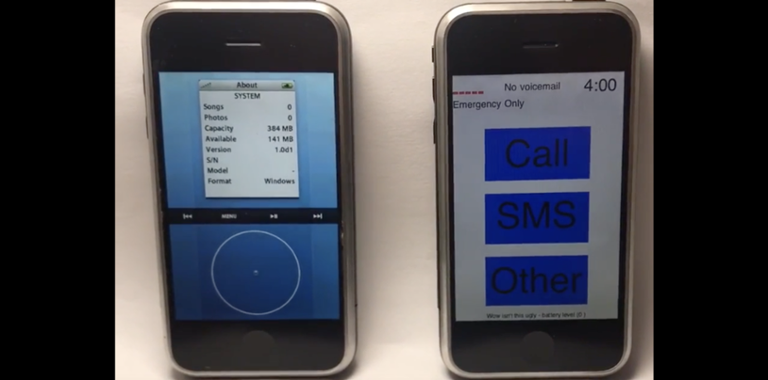As Apple's iPhone turns 10, we’re getting a preview of what it took to get iOS to this point. Established tech tipster Sonny Dickson posted a video this week showing the earliest prototypes of what we now know as iOS, and there’s a lot we can learn from it. In the video (below) you’ll see two different versions of iOS. Dubbed P1 and P2 by Dickson, the latter is the foundation of the mobile operating system many know and love. P1 (on the left in the video) was created by iPod chief and Nest founder Tony Fadell and his team, which is immediately clear when you see it in action. The second was created by Scott Forstall’s crew. Forstall worked on OS X, and had been with Steve Jobs since the NeXT days (and was fired because of a controversy related to the earliest version of Apple Maps). In retrospect, there’s a lot to glean from old tech. Here are our five takeaways.
Vision Is Important
P1 is basically iPod on a touchscreen. It’s recognizable, but not inspired. It doesn’t take advantage of the full breadth of a screen, and we have to believe that it would have flipped from the interface shown in the video to full-screen experiences for Maps and other specific apps. P2 is ugly as sin (if you look closely at the screen in our top image, there's a note that says "Wow isn't this ugly"!), but compared to the working iOS we have now (and even the version that shipped with the first iPhone), it’s raw marble before Michelangelo sculpted it into something beautiful: the outline is there. These early prototype versions of iOS show two very different ideas for the operating system. Conceptually, either works as a straightforward operating system, but only P2 would lead us to where we are now. The App Store and the cottage industry that sprung up around it would never have been as robust as it is now had Apple gone with P1. So we see that despite it being much better to look at, and more familiar, P1 would have limited the platform. Even this early, Apple was thinking about third-party support – and how to achieve it.
You’re Going to Be Wrong
Though it may seem like a ‘port’ of the iPod interface, getting P1 up and running on mobile hardware was still a bit of a feat. In a world where we’ve got a mature iOS and plenty of designated ‘kits’ to use with it, getting a click-wheel scrolling through a menu doesn’t seem so hard. But consider the time. Ten years ago, there was nothing like iOS or the iPhone, and it was new territory for all. Fadell’s team worked diligently to secure a working prototype that he could show off to decision-makers such as Steve Jobs. Instead, the P2 team was thinking differently and produced something much more profound. Fadell says that this was by design; Apple was working on 16 or 17 variants of iOS at the time. The P1 team (and so many others) was rebuffed for its efforts. It’s one of those times where you may believe strongly in your cause, but it’s just not going to work out in the end. Admitting you were wrong or failed is never easy, but it’s always necessary. 
Designers are Important
P1 was much closer to version 1.0 of iOS aesthetically, but it was still pretty rough around the edges. Unfortunately, P2 was worse for wear. Incidentally, Fadell insists both versions were created by UI teams, though he hasn't elaborated on whether that was driven by design or development. At this point, it’s pretty clear the respective teams were working independent of anyone else, as Apple’s secrecy for the first iPhone is well-documented. So we can safely guess that what we see is the result of teams trying to get a working prototype so they could discuss what was next in the process. It also highlights that, as much as those teams knew about code, good designers know an equal amount about pushing pixels. We may look back on the first consumer version of iOS and laugh, but the aesthetic ground covered between P2 and v1.0 of the "finished" iOS is astounding. If you’re in a position to work with a designer, get their input. Squeeze their delicate minds for all the rich UX and UI knowledge possible, and implement their expertise into your app or service. Thinking ahead is critical, but getting a good designer working on your project early on is also important.
Don’t Perfect the Imperfect
Speaking to The Verge, Fadell also said that Steve Jobs was sold on the iPod-as-a-phone concept with the virtual click-wheel:
A lot of us saw very early on that you couldn't make the clickwheel work for dialing a phone really quickly. So we’d say, “Steve, we don't want to spend time on this.” And Steve would go, "No, I want you to do it. Go and do it. You have to try it. Try.” We tried everything. We tried having little buttons on the clickwheel so you could click. There was a Nokia phone where they had a circular pattern for the numbers, in hard buttons, and Steve was like "Go make that work." So we tried that. And we went, "Steve, give it up, it's going to be too hard. It's not going to work." So we were halfway through, like four weeks or five weeks into it, and we said "This is not working." We pushed this for like another four, five weeks to keep trying, and we're saying, "This is a waste of time." But we had to be ready, because that's what he wanted. It was the same thing with the hardware keyboard. Steve said, "No, we're going to make this keyboard work, on the glass.”
That doesn’t mean P2 was neglected during that time, but that’s a lot of people-power spent on a concept that those working on it saw wasn't viable. It’s especially interesting because those working on the wheel were doing so because it was iconic, even though they didn’t believe in it for the iPhone. It’s hard to imagine how customers would have reacted to whatever P1 would have been had they never seen the P2 finished product... but iterating on a clumsy concept is a waste of time.
Always Be Challenging
Early on, Apple challenged its teams to perfect their projects. Since launch, it’s been constantly working to make things better across the platform. It’s not always perfect (looking at you, AirDrop), but it’s almost always better than the previous version. The first pass is obviously critical, but iteration is equally crucial. While changes may not always be apparent to users, working hard to improve your app or service is important. Challenging yourself to be objective about a pet project, especially when it comes to iteration, will lead to long-term success.



